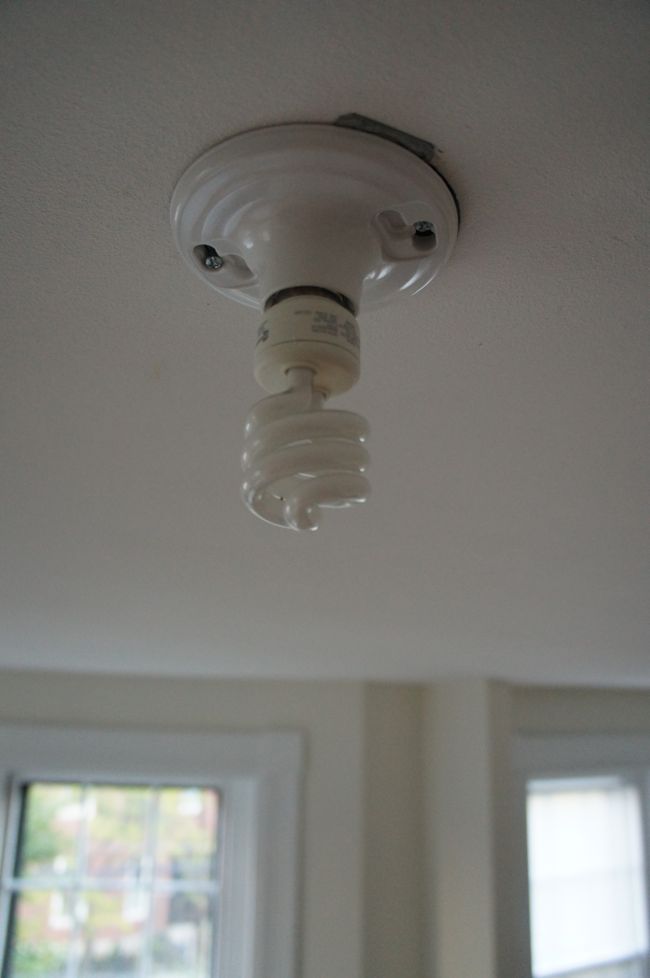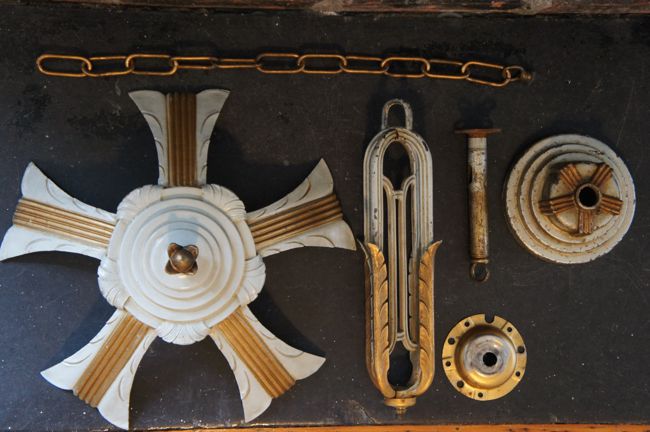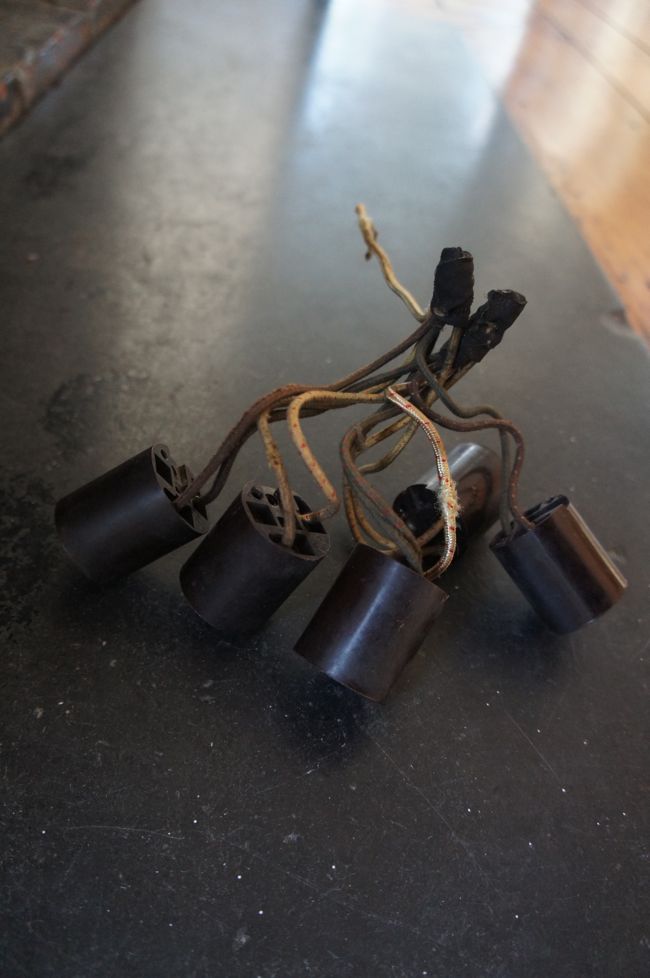About halfway through the kitchen renovation, my electrician added an outlet and an overhead light to the pantry closet. I had gutted the pantry down to the studs and lath, and as he worked, the electrician noticed that there was a small gap along the top of the pantry’s back wall. Through the gap, he could see into the space above the living room ceiling one room over. For whatever reason, an overhead light fixture was never installed in the living room, so the electrician offered to put one in. Since there were no walls in the pantry, he assured me that he could run wiring for the light fixture and wall switch through the pantry, without cutting any extra holes in the living room ceiling and walls.
At this point in the renovation, the kitchen and dining room were an uninhabitable construction zone. So we spent a lot of time in the living room, using it not only as a living room, but also as a temporary kitchen, dining room, and storage area. But up until this point, we had relied on a single lamp to light the room, which meant that after dark, low mood lighting was the only option in this space. Adding an overhead light would make our lives a lot easier. I gave the electrician the go-ahead, and the next day he installed wiring for the light fixture and switch and added a temporary bare bulb fixture to the ceiling.
Almost seven months later, that temporary bare bulb fixture is still there. It’s not so much that we never got around to getting a light fixture, it’s that I couldn’t decide on just the right fixture. It’s a big room, so a chandelier made sense. But did I want a modern chandelier to keep things from feeling too stuffy? Or would a chandelier that matches the room’s traditional architecture look better? And complicating things further, I soon found out that a lot of chandeliers are really expensive – like more than $1000 expensive – and I wasn’t prepared to spend that kind of money. After a few months of this indecision, Mara was like, just buy a light fixture already – anything will look better than a bare bulb. And she had a point. So I was ready to buy this perfectly acceptable, if somewhat unexciting, chandelier from Home Depot when I came across this chandelier on eBay.
It’s an art deco slip shade chandelier from the early 1930s made by Markel Electric Products, and it looked like a perfect fit for the living room. It’s a streamlined design, kind of like the Chrysler Building, with lots of bold lines and a few subtle, abstract leaf designs. This kind of slip shade light fixture was apparently really popular in the late 20s and early 30s. A lip around the edges of the glass slip shades allows them to rest on the chandelier frame with nothing more than gravity holding them in place. It’s an unusual design, and as far as I know, slip shade fixtures haven’t been produced since the early 40s. The overall style of the chandelier complemented some of the Greek Revival details in the living room, like the scroll design on the marble fireplace and the column-like window casing. It seemed like the ideal light fixture for the space.
Unfortunately, the seller was asking over $1000 for the chandelier. So I passed on it. But soon another identical chandelier showed up on eBay. It was also too expensive, but I started to wonder if these chandeliers are more common than I had previously thought. And then after some persistent searching, I began to notice parts of the same chandelier listed on eBay – a slip shade here, a ceiling canopy there. So I decided, against my better judgement, that I could buy all of the parts I needed on eBay and then refurbish and rebuild a complete chandelier for much less than it would cost to buy the same chandelier outright.
I found the chandelier frame and mast first. It was pretty beat up, but it would do. Sold. And luckily the same seller had listed the matching ceiling canopy separately, so I bought that as well, for a combined total of about $50.
These are theoretically all of the parts I need to put the chandelier frame together. As you can see, the original metallic paint finish is in pretty rough shape, so I’m planning to repaint everything with silver and gold metallic paint. But aside from the finish, the frame is in pretty good condition — it’s made out of heavy cast iron, so there’s not a lot that can go wrong there. The chandelier’s 80-year-old electrical components are a completely different story.
This decrepit, octopus-like bundle of wires is all that remains of the chandelier’s original wiring. I don’t want to mess around with ancient wiring that may or may not burst into flames the moment an electrical current is run through it, so I’m planning to buy new sockets and completely rewire the chandelier. This shouldn’t be too difficult, since all of the wiring sits exposed in the bowl of the chandelier.
All that I’m missing at this point is a complete set of five glass slip shades. The slip shades I need are particular to this light fixture. And since they’re made of glass and prone to breaking, they seem to be harder to come by, and more expensive, than the chandelier frame. So far, I’ve managed to buy three shades on eBay, ranging in price from $25 to $35 each. There are actually reproduction slip shades for this fixture available for $65 each, but I’d prefer to save some money and buy old shades. And in the meantime, while I’m scouring eBay for shades, I’ll get started painting and rewiring the chandelier frame.




Hi Dan, good to hear you’re still making improvements! Really curious to see what the chandelier will look like when finished!
That is SO cool. I love the art deco lines of the original. I would buy at least one extra shade while they are available, because when (not if) one of yours breaks, you’ll be glad you have one stashed.
Glad to see that the condo is coming along.